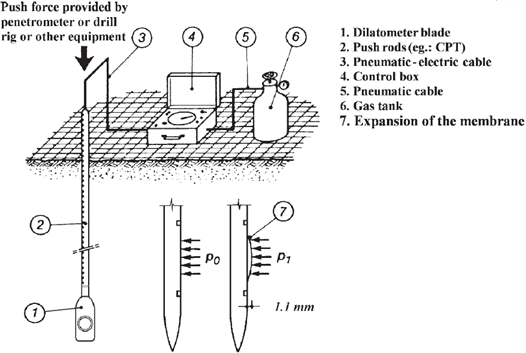DMT (Dilatometric Test)
The dilatometric test (DMT) is performed by using a dilatometric, which operates on the principle of verification of values by using the displacements of the inductive sensors (with a sensitivity of up to 0.001 mm). The advantage of these tests is a more accurate description of the displacement and deformation of foundation soil.
 General Layout of Dilatometer Test (source: [1], Figure 2, pp. 10)
General Layout of Dilatometer Test (source: [1], Figure 2, pp. 10)
The result of the dilatometric test is its process plotted as a graph. The evaluation of dilatometric tests (DMT) is used as input parameter for the analyses in the "Spread Footing", "Sheeting Check" and "Anti-Slide Pile" programs and for stratigraphic modeling in the "Stratigraphy" program.
The results of the dilatometric test (DMT) are imported into the program by inserting the file in format UNI (*.uni). It is a standardized and universal format for import of the measured data obtained from dilatometric tests, which is used in the world.
The name of the test and the vertical offset of the origin of the DMT is entered in the "New field test" dialog window. In the "Stratigraphy" program, the input of coordinations x, y, z is required.
The constrained soil modulus MDMT is entered in the table.
 Dialog window "New field test"
Dialog window "New field test"
Literature:
Marchetti, S., Monaco, P., Totani, G. & Calabrese, M.: The Flat Dilatometer Test (DMT) in soil investigations. A Report by the ISSMGE Committee TC16, University of L'Aquila, Italy, 2001, 48 p.
Roy E. Hunt: Geotechnical Engineering Investigation Handbook, Second Edition (CRC Press, 2005)
EN ISO 22476-11: Geotechnical investigation and testing - Field testing. Part 11: Flat dilatometer test